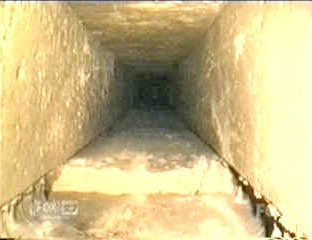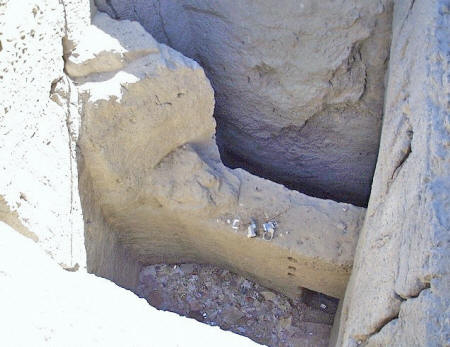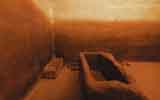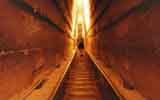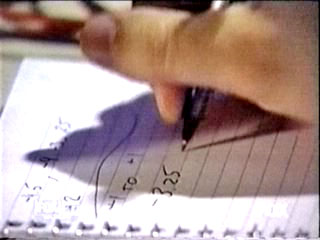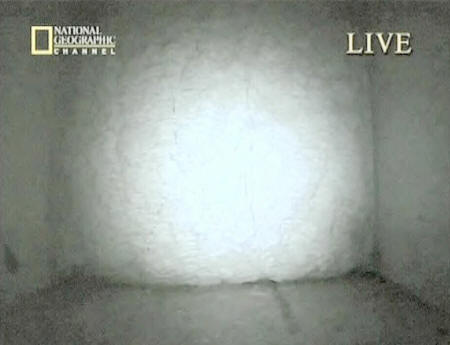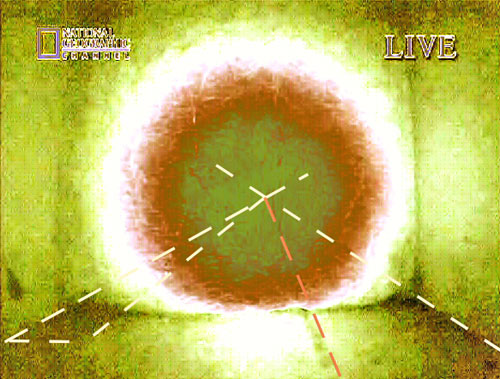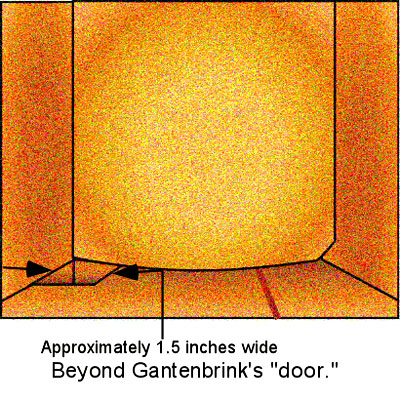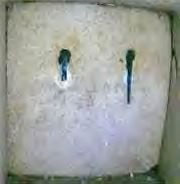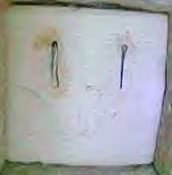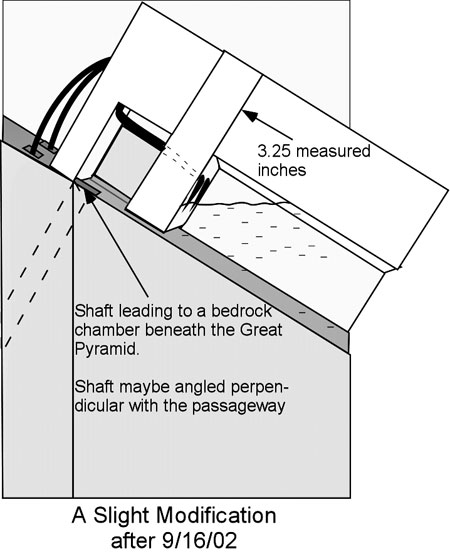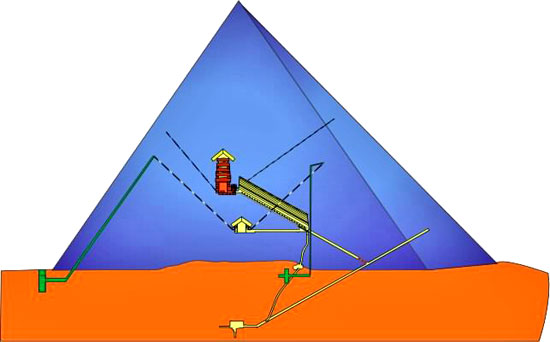|
from GizaPower Website
On Monday, September 16, 2002 at 8:00 PM ET, FOX television (US) broadcast live from Egypt an exploration of the Southern Shaft in the Queen’s Chamber in the Great Pyramid.
Since 1993, when German
robotics engineer, Rudolph Gantenbrink, made his initial exploration
of this 8-inch square 220-ft. long shaft, millions of Egypt watchers
around the world have been waiting for the day when additional
explorations would take place and another tantalizing barrier to
greater knowledge might be removed.
The "Pyramid Rover" is seen inside a 200-foot shaft of Egypt's Great Pyramid Tuesday,
prior to traveling
through the hole (center) that it had drilled in the door.
The preparatory work was fascinating. In order to determine the length of drill to be used, the team first had to know the thickness of the limestone block.
They used an ultrasonic thickness tester and
from those results, selected the proper drill. Then, a test rig was
assembled that simulated the shaft with a limestone block of
appropriate thickness at the end. Dr. Hawass observed the drilling
of the rock and gave the go-ahead for the team to drill through the
so-called "door."
Hawass’s comments were taken further by the Egyptian State Information Service:
German Egyptologist, Ranier Stadelman, who directed the work of Rudolph Gantenbrink in 1993, expressed a belief that the so-called door was a false door for the king’s soul to pass through on its way to Osiris, represented by the star Sirius.
He believed that the
copper fittings were handles that the king would use to lift the
door.
Dismissing my own
hypothesis on what would be behind the door, she claimed that they
would find a space 30 feet long that contained sacred sand.
(click image to enlarge)
Hawass’s pre-broadcast predictions were downgraded a week later to
On September 23, 2002, news came out of Egypt that the pyramid rover team had successfully explored the Northern Shaft in the Great Pyramid.
This shaft, opposite the Southern Shaft, posed problems for Gantenbrink in 1993, Upuaut II was unable to navigate around earlier explorers’ rods that were jammed in the passage as they attempted to push the rods around a bend in the shaft.
The Pyramid Rover, a custom-built robot, revealed yet another sealed door at end of the shaft inside Khufu's Great Pyramid
The iRobot team had a cunning but simple solution to the problem with which Gantenbrink was faced.
They turned the robot 90 degrees and sent it up the shaft
gripping the walls instead of the ceiling and floor. In this manner,
it was able to ride over the top of the obstacles.
You will notice that this block also has two metal fittings. Within the context of the power plant theory, the existence of these metal fittings is predictable. Also predictable are the characteristics of the fittings. The power plant theory describes a chemical process where two solutions combine to create hydrogen.
The Giza Power Plant theorizes that the Southern Shaft provided a diluted hydrochloric solution to the Queen’s Chamber and the Northern Shaft provided a hydrated zinc solution.
The function of these electrodes, i.e. the flow of electricity from one metal fitting through the liquid to the other metal fitting thereby creating a circuit, predicts that suspended metallic atoms in the fluid would be deposited on the cathode.
What is evident on these metal fittings, is the result of electrodeposition. Follow this link to learn more.
The evidence supporting the theory of dilute hydrochloric acid can be seen in the left photograph. The floor of the shaft obviously was eroded AFTER the pyramid was built.
This part of the floor in the Southern Shaft suffered erosion after the pyramid was built.
The theory proposed in the Giza Power Plant also proposes that the metal fittings known to
exist in the Southern Shaft were actually electrodes that served as
a means to signal when the level of chemicals in the shaft dropped
below a certain level.
On this point, Dr. Hawass and I agree. Behind the block at the end of the Northern Shaft they will discover another space similar to the one at the end of the Southern Shaft.
This time, I believe, they will find a shaft that is on the right side of the cavity. Perhaps in the floor, but possibly in the right wall.
The reason I say this is because of the vertical shafts on the east side of the Great Pyramid.
Vertical Shaft on the east side of the Great Pyramid
(click image to
enlarge)
The Southern Shaft connects to vertical shafts on the south side of the Great Pyramid and the Northern Shaft connects to vertical shafts on the East side of the Great Pyramid.
This is why the connecting
shaft beyond the Northern Shaft "door" will more than likely be
located on the East (right) side of the space that Hawass, and
myself, predict will be found when another exploration is made.
One conversant commented that even a vertical shaft that goes down into the bedrock would be incorporated into the tomb theory because,
His reason was that Egyptology
is not a hard science and does not need to conform to the same
standard.
(View only with Internet Explorer)
The features found in the King’s Chamber led me to propose the use of dilute hydrochloric acid in the Southern Shaft and hydrated zinc in the Northern Shaft of the Queen’s Chamber.
The features in the Grand Gallery led me to understand the function of the King’s Chamber. The features in the Queen’s Chamber indicate that a chemical reaction was taking place there to create hydrogen.
The hypothesis rises or falls on the evidence found in these areas.
For
the theory to hold together, evidence that is discovered in the
future has to support it. Some evidence, such as what will be found
behind Gantenbrink’s "door," can be predicted by what is found in
the chamber, the Southern Shaft and the Northern Shaft. The power
plant will be either vindicated or will be severely challenged or
even dismissed based on what is revealed.
I also predicted that on the backside of the "door" the copper fittings would have connections or would continue away from the "door" and to a point underneath the Great Pyramid.
Unfortunately, as of now, there have not been any clear images of the backside of the so-called door, so this part of the prediction has not been verified. However, the illustration in my book predicted one of the attributes of the "door" and the evidence vindicated this prediction.
In my illustration, the thickness of the block is given, by scale, as 3.64 inches thick. My measure was arbitrary and was based on nothing more than the proposed function of the block.
The ultrasonic thickness tester on the Pyramid Rover measured the actual thickness and found it to be 3.25 inches thick.
A Pyramid Rover team member records the thickness of the door.
Like everybody in the U.S., I was watching the video on FOX television.
In the top left corner was the word LIVE and the bottom left carried the FOX symbol with Channel 27. There was really nothing for me to become excited about by what I was able to gather on this broadcast, until a man in Germany uploaded provided a hi-res image that he had taken of the National Geographic program broadcast on Sky Television in Europe.
This image seemed to indicate that
there was more to be seen in the area that was occluded by the FOX
logo.
(click image to enlarge)
I know that if you stare at something long enough you might be able to see a face or some other shape, but the rectangular shape in the left corner of the new block became immediately apparent.
I then adjusted the levels, curves and colors to bring more definition to the image and created construction lines using the bottom corners as guides in order to create a vanishing point. It was my intention to see if the geometry of the rectangular shape on the left side was indeed a true rectangle and parallel with the wall.
Striking a line from the vanishing point and bringing it along the side of the rectangular shape, I became confident that I may have indeed discovered the down shaft that I had predicted would be there.
Interestingly, the line in the floor is also parallel to the
walls, which indicates that either the floor is made of two blocks,
or that a groove is cut in the floor. Notice, also, in this enhanced
image the signs of staining on the floor leading from the "down
shaft" end and also along the wall on the right side.
Moreover, if we look at the size of the vertical shaft behind the "door" by scale it is only about 1 1/2 inches wide and 4 inches long.
The exploration of the Northern Shaft and what was discovered at the end was predictable and, without any shadow of a doubt vindicates the purpose for these shafts as outlined in The Giza Power Plant.
The image of another "door" with copper fittings and the subtle difference between these fittings and those at the end of the Northern Shaft supports the hypothesis regarding the chemicals used. The electrodes are affected by different chemicals a different way. In the Southern Shaft, the action of the dilute hydrochloric acid eroded the copper over time.
Because the upper part of the copper was covered with chemical for a shorter period of time than the lower part, as the fluid was always falling, the lower part of the copper was eroded more that the upper part.
This resulted in a taper of the copper and the ultimate failure of the left electrode. In the Northern Shaft, we see a different effect. Because this shaft contained a hydrated metal, such as hydrated zinc, what we see is an electroplating of the left electrode.
This is normal and predictable considering that electricity flows from cathode (+) to anode (-) there would be a deposit of zinc on the anode. What we see in the photograph taken by Pyramid Rover is a white substance on the left electrode only. There is no erosion on these electrodes, and the thickness of the metal is considerably less than those in the Southern Shaft.
Notice also the stained limestone on the left and on top of the electrode. Studies on what causes this effect are still being made.
Southern Plug Northern Plug
While Egyptology is not considered to be a hard science, scientific standards should be employed when trying to explain this edifice.
Arguments should follow the rules of evidence and conform to scientific principles. While Egyptologists may say the tomb theory is unassailable, my view has been that if the tomb theory cannot follow logical scientific arguments, and be subject to radical revision when new data emerges, then it fails.
These are the
standards applied to alternate theorists, such as myself, so we
should expect no less from those who teach and support the accepted
view. Moreover, the theory should be predictable. What was
discovered behind Gantenbrink’s "door," though not yet brought into
full view, was not predicted by Egyptologists and does nothing to
support the theory that this edifice was originally a tomb.
Western born Egyptology should not be
immune from these scientific precepts, though its orthodox
protectors’ awkward attempt to force contradictory data to fit an
unsupportable hypothesis gives little hope for the prospects of
change.
An understanding of a glorious past with innumerable lessons for future generations.
|

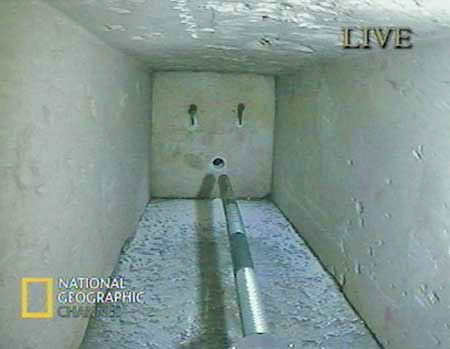
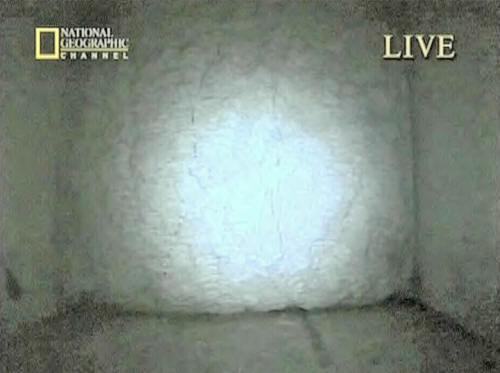

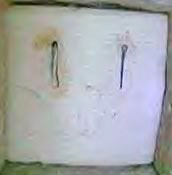 iRobot’s treck up the Northern Shaft revealed another blockage which
was similar, but not exactly the same, as Gantenbrink’s "door."
iRobot’s treck up the Northern Shaft revealed another blockage which
was similar, but not exactly the same, as Gantenbrink’s "door."